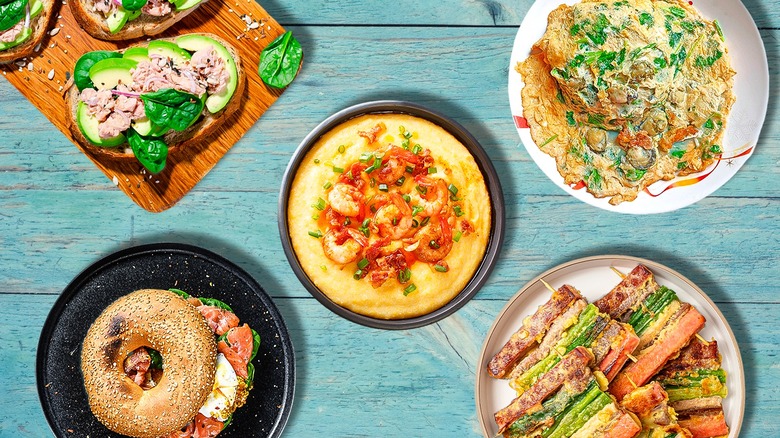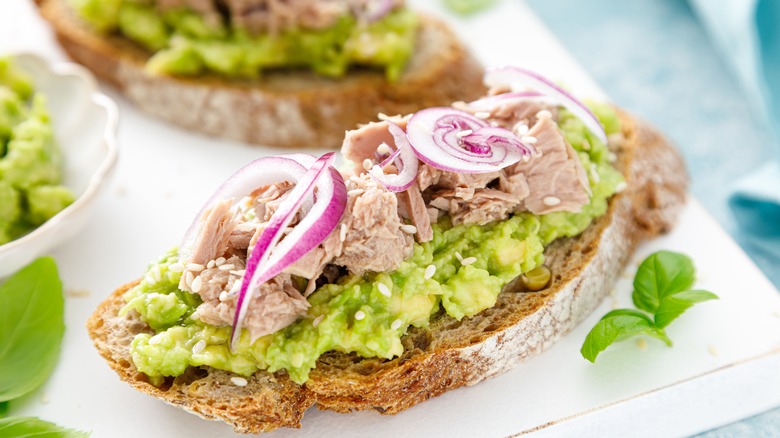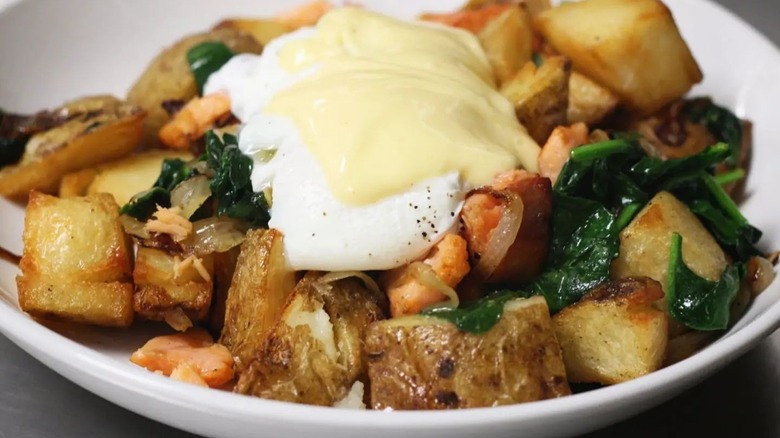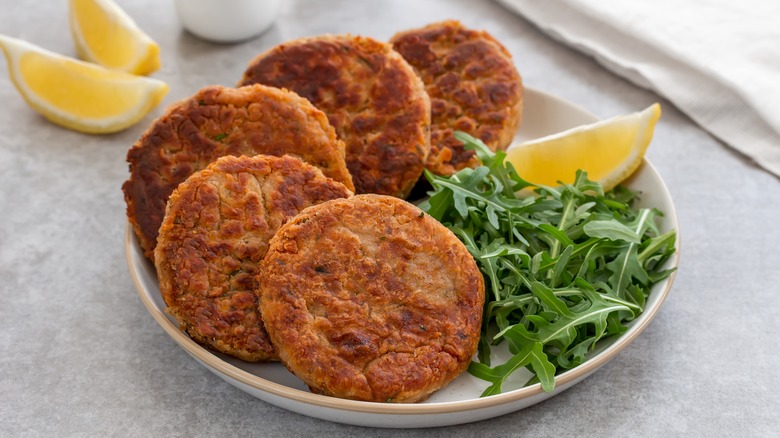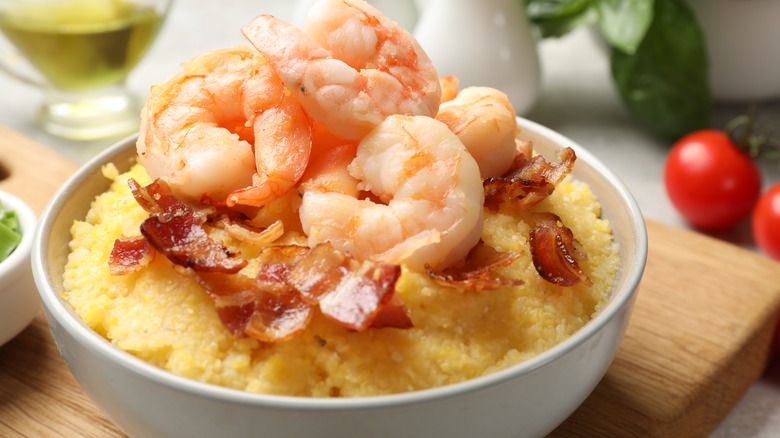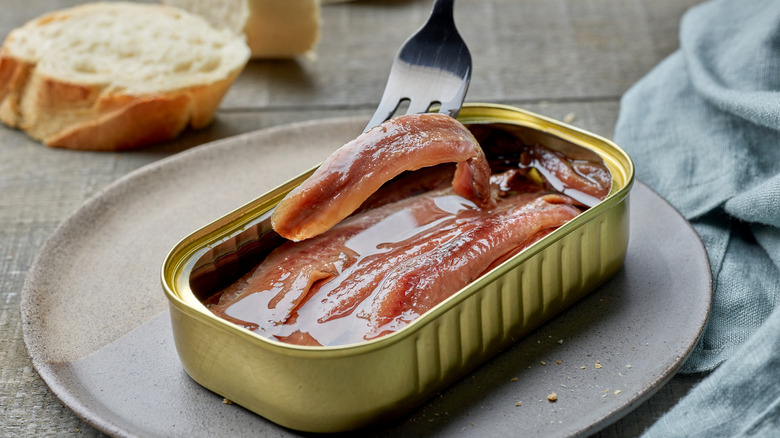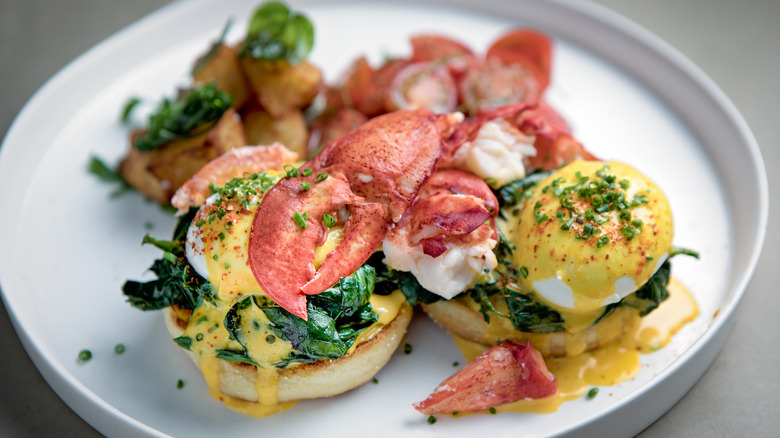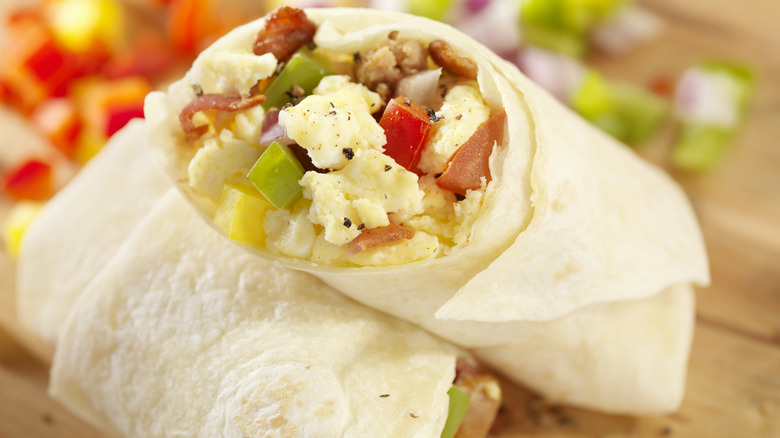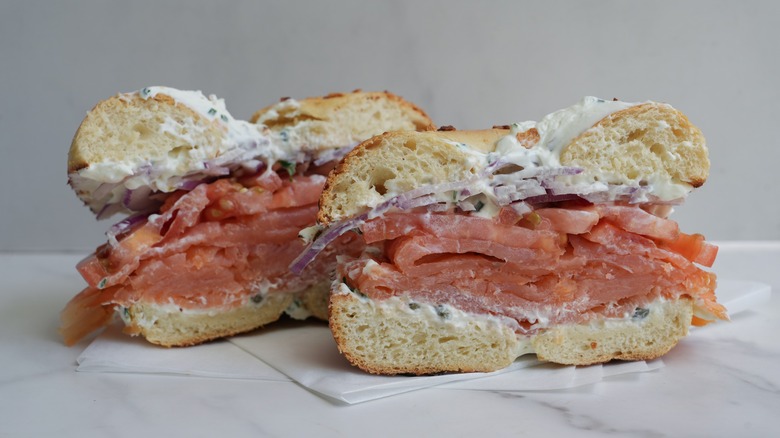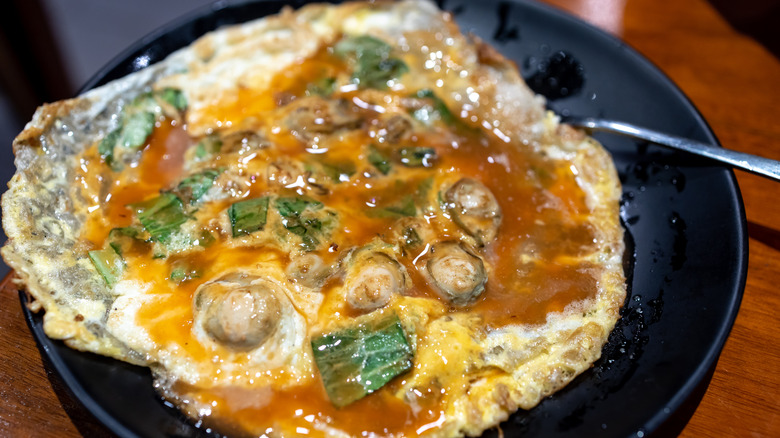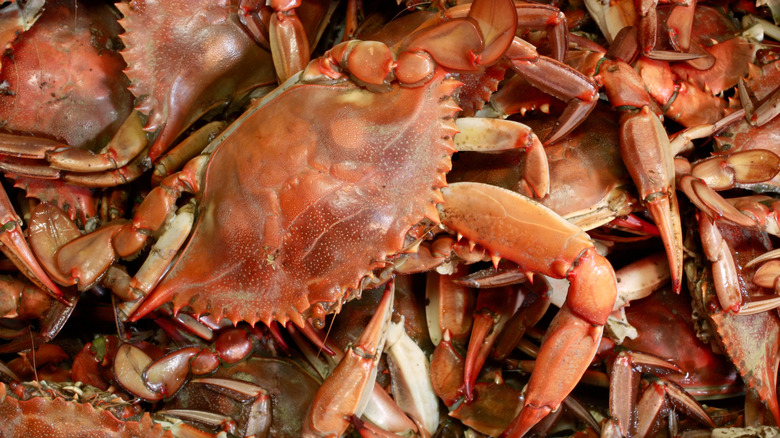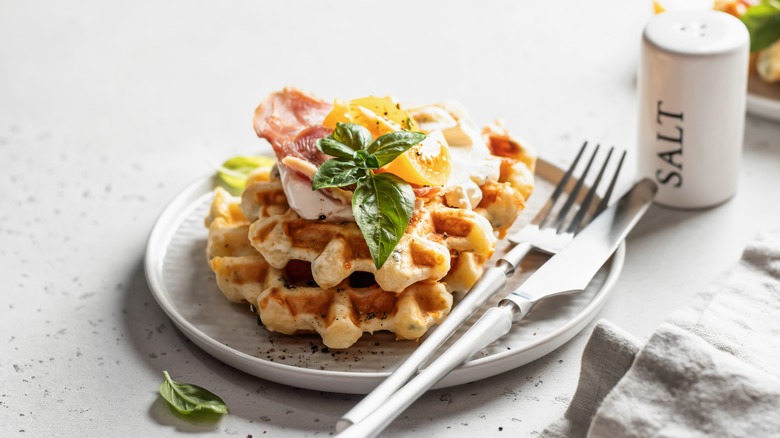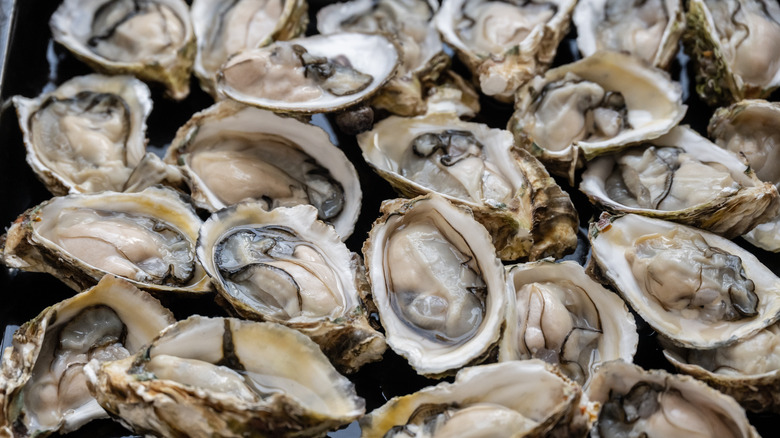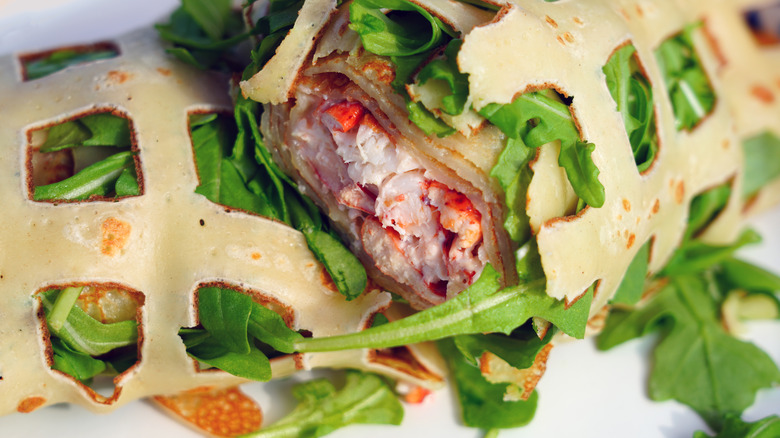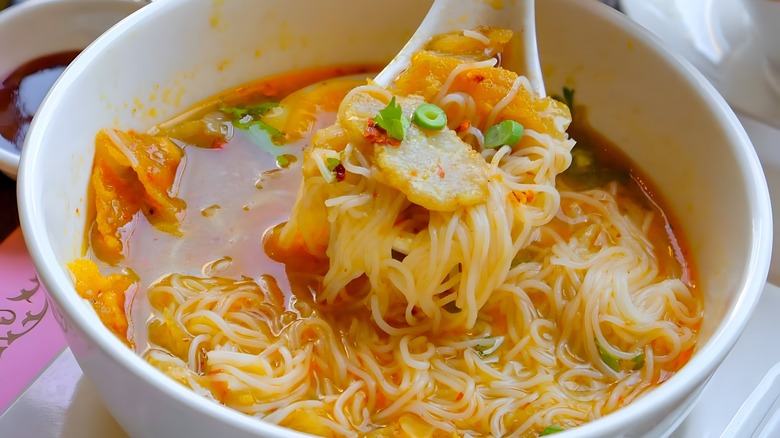17 Ways To Have Seafood For Breakfast
Breakfast is not only the most important meal of the day to kickstart your body into full gear, but it's also arguably one of the most satisfying ones, too. You have your traditional contenders, including eggs, bacon, toast, pancakes, waffles, and more. But then, you have your ingredients waiting in the wings for their chance to shine — like seafood.
Aside from popularized seafood breakfast dishes, like lox on a New York bagel or a steaming bowl of shrimp and grits, you may have never thought to add ingredients like canned tuna, lobster, and crab into your breakfast lineup. But what counts as "breakfast food" is all subjective. While you may have to swap out other ingredients or play with other flavors until you find the right balance, there is indeed a way to make seafood the star of your breakfast plate. Here are some simple suggestions to get you started.
1. Use canned tuna or salmon as a topping for your avocado toast
Avocado toast is one popular breakfast item that doesn't seem to be getting any less trendy. And when you think about it, it's kind of a perfectly engineered dish. You have the crisp, toothsome pull of the bread, along with a schmear of fatty, savory avocado on top. But what this breakfast combo is really missing is something salty to tie it all together, and that's where your favorite canned fish can come in.
The answer to what the best canned fish for avocado toast is will vary based on who you ask. Some folks prefer the briny and slightly funky flavor of canned sardines and mackerel. But if you aren't a fan of especially oily fish, you may opt for a more neutral canned salmon or tuna instead. You'll still get that uniquely salty flavor, but with less of that fresh-from-the-sea overtone that turns many people off foods like canned sardines.
You don't have to stop with just the fish either. Layer on pickled red onions, sliced tomatoes, or a sprinkle of your favorite seasoning to breathe new life into this Instagram-worthy breakfast.
2. Serve a crispy salmon hash as a side dish
Hash is one of the most under-appreciated breakfast foods out there. And really, it's not just a breakfast food — it's a playlist of all the top hits of the breakfast table. Not only do you have your boiled and pan-fried potatoes, but you also have a vegetal boost from sauteed onions and peppers, as well as an array of toppings like poached eggs, herbs, and hollandaise sauce. But the magic doesn't stop there; you should also consider adding something fishy to your plate for extra saltiness and flavor.
A crispy salmon hash is the perfect breakfast for seafood lovers. You can incorporate your leftover salmon from the night before and mellow out the brininess with fresh dill. The key is to add the salmon to the mix after the potatoes have already cooked down. Adding it prematurely may cause the salmon to dry out and overcook.
3. Channel all things umami with a tuna patty base
Eggs Benedict is one breakfast food that should be reserved for eating at a well-established breakfast spot. It's a painstaking process to perfectly poach the eggs and whip up a properly emulsified hollandaise sauce. But we may consider trying this classic breakfast recipe at home if tuna patties are involved.
These patties can act as the flavorful base for an upgraded eggs Benedict. You can start with a simple tuna patty recipe, made with canned tuna, binders like mayonnaise and mustard, shallots, and breadcrumbs. Once the patties are pan-fried, they can take the place of your English muffin. Like crab cakes, you should always serve your tuna patties hot; otherwise, they can make your breakfast taste especially greasy. Besides that, you should also take the liberty of seasoning your patties to help complement the toppings on your Benedict. A little drizzle of hot sauce or some spicy peppers can bring up the spice level, while some fresh herbs like dill can transport your tastebuds to the Mediterranean.
4. Enjoy a taste of the South with shrimp and grits
We would be remiss not to mention shrimp and grits as one of the best (and most classic) ways to enjoy seafood for breakfast. An old-fashioned shrimp and grits recipe is relatively easy to whip up; all you need are grits, cheddar cheese (which imparts a beautiful yellow hue and keeps this dish in the breakfast domain), and peeled and deveined shrimp. The grits, which are cooked with water, and the shrimp are cooked separately, then combined together in one bowl for a beautiful and tasty breakfast.
You should always opt for raw shrimp for making your shrimp and grits. While it may seem simpler to grab a bag of frozen, pre-cooked shrimp, the raw shrimp are noticeably juicier. If you don't have access to a seafood deli counter, you could opt for frozen, uncooked shrimp; just be sure to thaw them in water before you use them. You also can't take shortcuts with your grits; classic, hominy grits, rather than the instant variety, are the way to go.
5. Whip up a fishy compound butter to use for your breakfast favorites
Biting into a whole filet of fish before 10 a.m. isn't our idea of a fun time. If you too are at odds with the thought of eating a piece of fish so early in the morning, rest assured that you can always use it as an ingredient or flavoring agent instead. For example, if you're looking to step up your compound butter, try popping open a can of anchovies. Anchovies are notably rich in umami, which means that they can add a level of complexity to your butter that other ingredients can't.
You'll want to first start by mashing up or whipping your butter so that the anchovies can be easily incorporated. You don't need to use a salted butter, either, since the fish and the oil they're canned in should be enough. These tiny fish are also notably quite pungent, so you'll want to start with two filets per stick of butter and then go from there. Once your anchovies are well-mixed into the butter (some small bones are inevitable, since you are using the whole filet), you can set it in the fridge to harden.
Anchovy butter can be used for all hours of the day. But you might want to try a swipe on your English muffin or toast to start.
6. Try a lobster Benny
If you visit nearly any upscale restaurant serving breakfast in New England, you're bound to find a lobster Benedict on the menu. The plain eggs Benedict, featuring an English muffin, poached egg, and hollandaise sauce, is enough, but someone came along and had to add a premium seafood to the mix, too. Honestly, we're not complaining.
The best kind of lobster to use for this classic breakfast dish is undeniably butter poached. If you're just starting to work with lobster, it might be easier to try butter poaching the tails first, and then graduating to the knuckle and claw meat. Once your meat has soaked in the butter, you can transfer it to the top of your English muffin. This seafood is especially rich (as are all of the items atop the muffin), so you'll want to add a small pile to each rather than making it a lobster-with-a-side-of-eggs-Benedict kind of breakfast dish.
7. Stuff shrimp into your breakfast burrito
Breakfast burritos are arguably a garbage disposal for all of the ingredients that you have stocked up in your fridge and your pantry that are almost ready to be tossed in the trash. While conventional breakfast burritos may include ingredients like eggs, cheese, spinach, and sausage, you can always take things a step further and add more flavorful selections, including shrimp.
Shrimp is a great addition to your breakfast burrito because they mimic that toothsome texture of a sausage without the gnarly gristle. The flavor is also milder, so it will allow seasonings to take to the forefront of this dish. Try cooking your peeled, deveined shrimp down with some cumin to add extra warmth. Frozen shrimp will work well in a pinch here, but just be sure to defrost the protein entirely before cooking it in the pan.
8. Don't forget about a bagel with lox
When you think about how to eat seafood for breakfast, one obvious one that might come to mind is the classic bagel and lox combo. Loaded lox bagels are easy to make at home, too — as long as you have access to a quality purveyor of preserved fish. The key difference between lox and smoked salmon is that, while both are cured in either dry salt or a salt brine, smoked salmon is then just that — smoked. You can play with both ingredients on your bagel of choice, depending on what flavors you're looking for.
But a bagel with lox is more than just that. It's also an interplay of delicious toppings, including capers, dill, red onions, pickles, and more. The squishy, New York-style bagel is the perfect cushion for the heft of these toppings, but you could also swap it out for a humble slice of toast or crispbread, too.
9. Try a tasty Taiwanese oyster omelet
American eaters may never have the chance to try a Taiwanese oyster omelet in a restaurant, but that doesn't mean you can't try to make it at home. Although o ah jian, as its otherwise known, may be a common find in Taiwan's food stalls, it is originally a product of China. The omelet includes a handful of small, shucked oysters, along with conventional omelet ingredients like eggs, cooking oil, and a bit of starch to help it hold together. But one of the most important parts of making a proper Taiwanese oyster omelet is to layer it up with a sweet-and-sour tomato sauce, made with ketchup, rice vinegar, soy sauce, and more. It's a condiment that you may want to bottle up to use for other dishes.
The oysters add a toothsome texture to the omelet, as well as a briny flavor that takes it to the next level. Plus, the mollusks play with the sauce well and result in a wholesome, complete bite.
10. Use smoked fish to upgrade your huevos rancheros
Huevos rancheros are a breakfast dish that you'll be hooked on (fish pun intended) at first bite. This dish is kind of like a Tex-Mex take on North African shakshuka. The poached eggs are cooked in a thick, tomato-forward sauce packed with veggies and beans. Once the dish is finished cooking, it's often served on fresh awaiting tortillas or a slice of hearty bread.
It might seem like this dish can't get any better, but it actually can! Smoked fish, like salmon and mackerel, can dial up the savory notes of your eggs and help accent the existing seasonings in the sauce. If you do enough digging, you may be able to find a complementary smoked fish with some of the same flavors and ingredients. Fishwife, a tinned seafood brand, for example, makes a smoked mackerel with chili flakes that would be an excellent sprinkle for huevos rancheros.
11. Chop up shrimp or crab for your corn muffins
Corn muffins and cornbread, as a whole, can be easily tweaked to lean sweet or savory with only a couple of extra ingredients. Adding shrimp or crab to your batch, for example, will surely tip the scales toward all things savory. The key to making this baked good a success, though, is to not just dump in the seafood and walk away. Instead, you'll want to add other savory elements to segue into the fishy components. Layer in some Cajun seasoning, cumin, paprika, or other spices to up the heat. Or go spicy with jalapeños or a hefty dose of cayenne.
Not a baker? Get your hands on a box of store-bought cornbread mix and adapt the recipe to fit in your muffin tin. You'll only need a few extra ingredients to make this quick breakfast side.
12. Add fresh crab to your eggs
Eggs and bacon are overrated. Why not try something more out of the box and take a stop by your seafood counter instead? After all, eggs really need that unique, briny boost to help round out their flavor a little bit more. That's where fresh crab meat can come in. It's not as clearly fish-like as some other types of seafood, which means that it can impart a more pleasant, subtle flavor to your eggs without taking center stage.
The most important thing to know about making a batch of scrambled eggs with crab meat is that the crab doesn't cook at the same rate as the eggs. There's nothing worse than overcooked eggs, so you'll want to cook down the fresh lump crab meat in a pan long before you think about cracking open an egg. This will give ample time for the moisture in the crab to dissipate and will prevent a watery scramble.
13. Top your savory waffle with smoked fish
Sweet waffles have had their time in the spotlight. It's now time to give the microphone over to their foil: the savory waffle. This waffle variety can encompass a wide range of bases, ranging from a potato-hash-turned-waffle to a savory batter accentuated by spices, cheese, and meat. The type of seafood you pair with this waffle will really depend on the textures and flavors that are already in the base. For example, if you have a tin of smoked salmon handy, you can cut it into small pieces and stir it directly into the gloopy batter before you add it to the iron. The salty and smoky flavor of the fish makes it a great accompaniment to bacon or even a drizzle of maple syrup.
Potato waffles, on the other hand, pair exceptionally well with a mild smoked trout. Add a scoop of crème fraîche and a sprinkle of scallions to help balance out the saltiness of the fish and the spuds.
14. Try a Korean crab jeon
One of the most budget- and fridge-friendly types of seafood out there is imitation crab. The name is slightly deceptive, though, as imitation crab is actually made from surimi, aka whitefish or Alaskan pollock. As a result, this faux crab doesn't have the same distinct flavor as fresh crab, but it does have that unique, toothsome texture that will make you feel like you're eating the real thing.
Imitation crab too has its place at the breakfast table, including as a part of Korean crab jeon. The imitation crab sticks are first pulled apart like cheese sticks before being mixed with other omelet ingredients like peppers and onions. These patties are typically kept smaller than the classic American omelet and are served as a side dish or a quick bite.
15. Swap out classic gravy for an oyster one
Sausage and gravy is a common breakfast dish across large swaths of the U.S. Typically, the dish is made with a white, sausage-based gravy that oozes over the freshly baked buttermilk biscuit. But sausage isn't the only gravy base that you can use. Instead, turn to briny, chopped oysters for this twist on a classic dish.
You'll want to first start this recipe by cooking down your aromatics, like shallots, and deglazing the pan with wine. Fish stock is a critical ingredient here because it not only helps thicken up the white gravy, but also acts as a bridge to the oysters, which are added to the mixture later. Overcooking these mollusks would be a tragedy; you only need to leave them in the gravy long enough that the edges start to twist and turn. Then, serve the mixture hot over your biscuits.
16. Stuff your crepes with lobster
Crepes seem like a natural pairing for sweet things, including Nutella and fresh fruit. But savory crepes are just as worthy of your breakfast plate. And what better way to bring a refined, sophisticated element to your crepe than with lobster?
One popular variation of this dish is the lobster Newberg, which was initially popularized at Delmonico's in NYC. The crepe itself is a sweet one, but the filling leans savory, thanks to the lobster tails, dry sherry, brandy, shallots, and the butter — a lot of butter. If you're ballin' on a budget, you can also substitute out some of that lobster meat with cheaper options, including lump or claw crab meat, shrimp, and scallops. Pair it with a solid cream sauce, and you'll have a delicious crepe you surely won't forget.
17. Make a savory breakfast soup called mohinga
Seafood may not be as popular in American breakfasts, but that doesn't mean you can't find it in cuisines around the world. One example is mohinga, a cozy fish soup perfect for a hearty breakfast. This soup kicks things off with a catfish base and pungent aromatics. The bowl is typically served with eggs or fritters and can be found in food stalls across Myanmar.
The good news is that you won't have to travel halfway around the world to try this soup. You can make your own broth with catfish, along with fish sauce and shrimp paste for extra oomph. The aromatics, like lemongrass, garlic, and ginger, are a key building block to this soup and are available at ethnic markets or the international aisle of major grocery stores.
